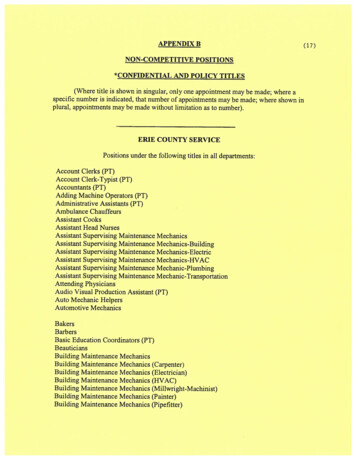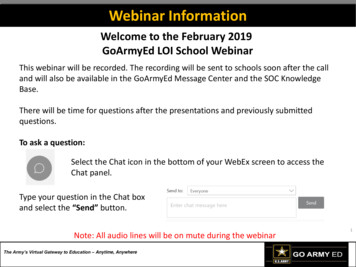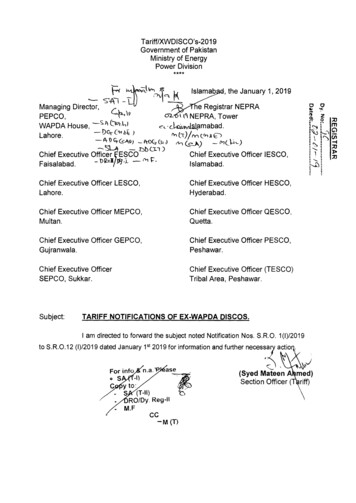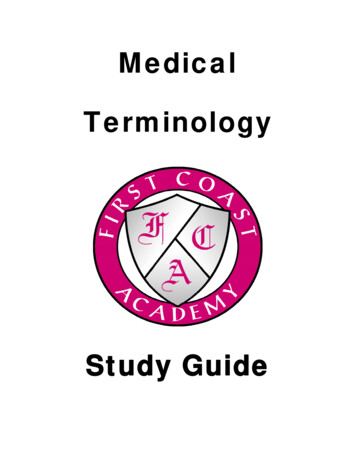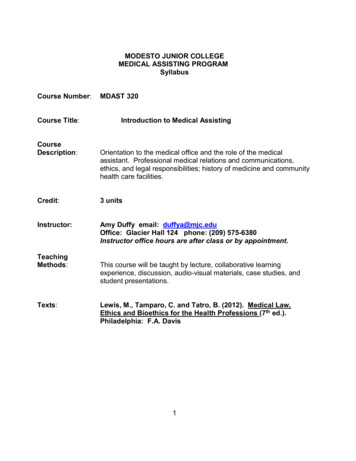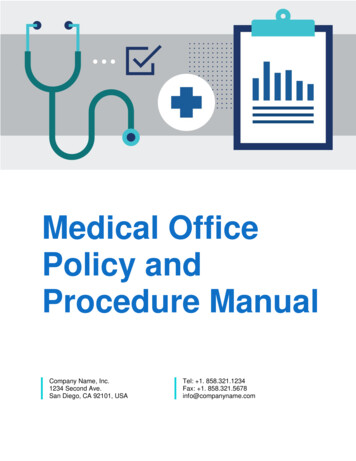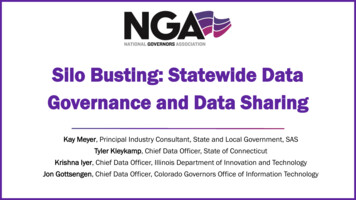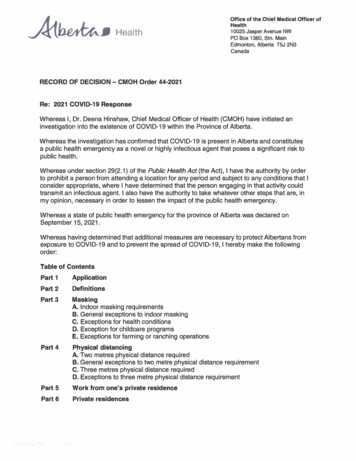
Transcription
.A1. HealthOffice of the Chief Medical Officer ofHealth10025 Jasper Avenue NWPO Box 1360, Stn. MainEdmonton, Alberta T5J 2N3CanadaRECORD OF DECISION - CMOH Order 44-2021Re: 2021 COVID-19 ResponseWhereas I, Dr. Deena Hinshaw, Chief Medical Officer of Health (CMOH) have initiated aninvestigation into the existence of COVID-19 within the Province of Alberta.Whereas the investigation has confirmed that COVID-19 is present in Alberta and constitutesa public health emergency as a novel or highly infectious agent that poses a significant risk topublic health.Whereas under section 29(2.1) of the Public Health Act (the Act), I have the authority by orderto prohibit a person from attending a location for any period and subject to any conditions that Iconsider appropriate, where I have determined that the person engaging in that activity couldtransmit an infectious agent. I also have the authority to take whatever other steps that are, inmy opinion, necessary in order to lessen the impact of the public health emergency.Whereas a state of public health emergency for the province of Alberta was declared onSeptember 15, 2021.Whereas having determined that additional measures are necessary to protect Albertans fromexposure to COVID-19 and to prevent the spread of COVID-19, I hereby make the followingorder:Table of ContentsPart 1ApplicationPart 2DefinitionsPart 3MaskingA. Indoor masking requirementsB. General exceptions to indoor maskingC. Exceptions for health conditionsD. Exception for childcare programsE. Exceptions for farming or ranching operationsPart 4Physical distancingA. Two metres physical distance requiredB. General exceptions to two metre physical distance requirementC. Three metres physical distance requiredD. Exceptions to three metre physical distance requirementPart 5Work from one's private residencePart 6Private residences
Page 2Part 7Private social gatheringsA. Private social gatherings for protestsPart 8Places of worshipPart 9Businesses and entitiesPart 1 ORestaurants, cafes, bars and pubsPart 11Adult physical activity, performance activity and recreational activityA. Professional physical activities and performance activitiesPart 12Youth activityPart 13SchoolsA. Physical distancing in schoolsB. Masking requirements in schoolsC. Exceptions to masking in schoolsD. School busesE. Exception to masking where physical distancing can be maintainedPart 14Exemptions under Alberta Government's Restrictions Exemption ProgramPart 15GeneralPart 1 - Application1.1This Order applies throughout the province of Alberta.1.2This Order comes into force on September 20, 2021 except where otherwise stated inthis Order.1.3If a section of this Order is inconsistent or in conflict with a provision in Record ofDecision - CMOH Order 10-2020, 37-2021 or 38-2021, the section in those Ordersprevail to the extent of the inconsistency or conflict.1.4This Order amends CMOH Order 42-2021 by making the following amendments to Part 7effective September 16, 2021:(a) deleting sections 7.1 through 7.6; and(b) substituting the words "Despite this Part of this Order, a" with "A" in section 7.7.1.5This Order rescinds CHOH-Order 42-2021 effective September 20, 2021.Part 2 - Definitions2.1In this Order, the following terms have the following meanings:(a) "adult" means a person who has attained the age of eighteen years.
Page3(b) "authorizing health professional" means one of the following regulated membersunder the Health Professions Act who holds a practice permit:i.nurse practitioners;ii. physicians;iii. psychologists.(c)"child care program" means any of the following:i.a facility-based program providing day care, out of school care or preschool care;ii. a family day home program;iii. a group family child care program;iv. an innovative child care program.(d) "Class A, B or C liquor licence" has the same meaning given to it under the Gaming,Liquor and Cannabis Regulation, AR 143/96, under the Gaming, Liquor andCannabis Act.(e) "cohort'', as the context of this Order requires, means:i.for a person who resides on their own, one or two other persons with whom theperson who resides on their own regularly interacts with during the period of thisOrder;ii. for a household, the persons who regularly reside at the home of that household;iii. for a household in which all eligible persons who regularly reside at the home arefully vaccinated, the members of that household and the members of a secondhousehold whose eligible members are fully vaccinated, up to a maximum of tenfully vaccinated persons, excluding children eleven and younger who are notvaccinated. This must be the same two households for the duration of the Order;iv. for a fully vaccinated person who resides on their own, the person who resideson their own, and up to a maximum of nine fully vaccinated persons, excludingchildren eleven and younger who are not vaccinated. This must be the same ninepeople for the duration of the Order;.v. for a person attending an overnight camp, the group of campers and staff.members assigned to them who stay together throughout the day, day to day,and overnight;vi. for a school, the group of students and staff who primarily remain together for thepurposes of instruction as a COVID-19 safety strategy.(f)"commercial vehicle" means a vehicle operated on a highway by or on behalf of aperson for the purpose of providing transportation, but does not include a privatepassenger vehicle.(g) "day care" has the same meaning given to it in the Early Learning and Child CareRegulation.
Page4(h) "drive-in activities" means outdoor activities that a person can participate in orobserve while remaining in a motor vehicle including the following:i.a worship service;ii.a drive-in movie;iii.a graduation ceremony;iv.physical activity, performance activity or recreational activity;v.any activity similar in nature to those listed in this definition.(i) "eligible person" means a person born in 2009, or before 2009, who is living, workingor going to school in Alberta who is eligible to receive the COVID-19 vaccine.0) ''face mask" means a medical or non-medical mask or other face covering thatcovers a person's nose, mouth and chin.(k) ''facility-based program" has the same meaning given to it in the Early Learning andChild Care Act.(I) "Facility Licence" has the same meaning given to it under the Gaming, Liquor andCannabis Regulation, AR 143/96, under the Gaming, Liquor and Cannabis Act.(m) ''family day home program" has the same meaning given to it in the Early Learningand Child Care Act.(n) ''farming or ranching operation" means the primary production of eggs, milk, grain,seeds, fruit, vegetables, honey, livestock, diversified livestock animals within themeaning of the Livestock Industry Diversification Act, poultry or bees, an operationthat produces cultured fish within the meaning of the Fisheries (Alberta) Act, and anyother primary agricultural operation specified in the regulations, but does not includethe operation of a greenhouse, mushroom farm, nursery or sod farm.(o) ''fitness activity" means a physical activity that occurs at a gym, fitness studio, dancestudio, rink, pool, arena or recreation centre and includes dance classes, rowing,spin, yoga, boxing, boot camp, Pilates and other activities of a similar nature.(p) ''food-serving business or entity'' means a restaurant, cafe, bar, pub or similarbusiness or entity.(q) ''fully vaccinated" means a person who is eligible for vaccination who has:i.received two doses of a World Health Organization approved COVID-19vaccine in a two dose vaccine series or one dose in a one dose vaccineseries; andii.had fourteen days elapse since the date on which the person received thesecond dose of the World Health Organization approved COVID-19 vaccineof a two dose series or one dose of the vaccine in a one dose vaccineseries.
Page 5(r) "Gaming Licence" has the same meaning given to it under the Gaming, Liquor andCannabis Regulation, AR 143/96, under the Gaming, Liquor and Cannabis Act.(s) "group family child care program" has the same meaning given to it in the formerChild Care Licensing Regulation.(t) "health condition" means the following mental or physical limitations:i.sensory processing disorders;ii. developmental delays;iii. mental illnesses including: anxiety disorders; psychotic disorders; dissociativeidentity disorder; and depressive disorders;iv. facial trauma or recent oral maxillofacial surgery;v. contact dermatitis or allergic reactions to face mask components; orvi. clinically significant acute respiratory distress.(u) "highway'' means any thoroughfare, street, road, trail, avenue, parkway, driveway,viaduct, lane, alley, square, bridge, causeway, trestleway or other place or any partof any of them, whether publicly or privately owned, that the public is ordinarilyentitled or permitted to use for the passage or parking of vehicles and includes:i.a sidewalk, including a boulevard adjacent to the sidewalk;ii. if a ditch lies adjacent to and parallel with the roadway, the ditch; andiii. if a highway right of way is contained between fences or between a fence andone side of the roadway, all the land between the fences, or all the land betweenthe fence and the edge of the roadway, as the case may be,but does not include a place declared by regulation not to be a highway.(v) "innovative child care program" has the same meaning given to it in the former ChildCare Licensing Regulation.(w) "masking directive or guidance" means, as the context of this Order requires, either:i.a directive or guidance document made by a regional health authority, or acontracted service provider of a regional health authority, which sets outdirections or guidance respecting the use of face masks in facilities or settingsoperated by the regional health authority or the contracted service provider; orii. a directive or guidance document made by Alberta Health and posted on theGovernment of Alberta website.(x) "medical exception letter'' means written confirmation provided to a person by anauthorizing health professional which verifies that the person has a health conditionthat prevents the person from wearing a face mask while attending an indoor publicplace andi.clearly sets out the information required by section 3.6 of this Order; andii. is valid for a period of one year from the date on which it is made.
Page 6(y) "outdoor food and beverage services" means services which an operator of a food serving business or entity provides in an outdoor area to persons who remain at thefood-serving business or entity while consuming food or beverages. For greatercertainty, outdoor food and beverage services are provided in an area that meet thefollowing requirements:i.patios and dining areas with a roof must not have more than one enclosingwall;ii.patios and dining areas without a roof may have one or more enclosing wall;iii.for the purposes of this Order umbrellas and pergolas are not considered tobe roofs;iv.for the purposes of this Order, a fence or a half-wall is not an enclosing wall.(z) "out of school care" has the same meaning given to it in the Early Learning and ChildCare Regulation.(aa) "performance activity'' means singing, playing a musical instrument, dancing,acting or other activities of a similar nature and includes, but is not limited to, arehearsal, concert, theatre, dance, choral, festival, musical and symphony events.(bb) "person who resides on their own" means a person living on their own or a personliving on their own who has one or more youth living with them and under theircare.(cc) "physical activity'' means a fitness activity or sport activity.(dd) "preschool care", has the same meaning given to it in the Early Learning and ChildCare Regulation.(ee) "post-secondary institution" means a public or private post-secondary institutionoperating under the Post-Secondary Learning Act and includes the physical locationor place where the post-secondary institution provides a structured learningenvironment through which a program of study is offered.(ff)"private place" means a private place as defined under the Public Health Act.(gg) "private social gathering" means any type of private social function or gathering atwhich a group of persons come together and move freely around to associate, mixor interact with each other for social purposes rather than remaining seated orstationary for the duration of the function or gathering, but does not include a cohortconsisting of persons referred to in section 2.1 (e) of this Order.(hh) "public place" has the same meaning given to it in the Public Health Act, and forgreater certainty does not include a rental accommodation used solely for thepurposes of a private residence.(ii) "recreational activity'' means any structured or organized activity or program wherethe purpose of the activity or program is intended to develop a skill, including but not
Page7limited to, Girl Guides, Scouts, arts and crafts, pottery or other substantially similaractivities.OD"school" has the same meaning given to it in the Education Act.(kk) "school building" has the same meaning given to it in the Education Act.(II) "Special Event Licence" has the same meaning given to it under Gaming, Liquor andCannabis Regulation, AR 143/96, under the Gaming, Liquor and Cannabis Act.(mm) "sport activity'' means sports training, practices, events, games, scrimmages,competitions, gameplay, league play, and other activities of a similar nature.(nn) "staff member'' means any individual who is employed by, or provides servicesunder a contract with, an operator of a school.(oo) "student'' has the same meaning given to it in the Education Act.(pp) ''visitor'' means any individual who attends a school, but who is not a student or staffmember.(qq) ''youth" means a person under eighteen years of age.(rr) ''youth activity'' means any physical activity, performance activity or recreationalactivity youth are participating in.Part 3 - MaskingA. Indoor masking requirements3.1Except as set out in this Order and subject to Part 13, a person must wear a face maskat all times while attending an indoor public place.3.2For greater certainty, indoor public places include, but are not limited to:(a) a school building;(b) commercial vehicles transporting the driver and one or more other persons who arenot members of that persons household, or if the person is a person living alone,then the person's close contact;(c) the common areas of a day camp or overnight camp; and(d) all indoor spaces under the control of a business or entity, including all areas wherethe public or employees of the business or entity may attend.3.3For greater certainty, except as otherwise set out in this Order:(a) face masks must be worn at a wedding ceremony or funeral service that is held inan indoor public place; and(b) a person must comply with all masking directives or guidance while attending at afacility operated by a regional health authority under the Regional Health Authorities
Page 8Act or a facility operated by a contracted service provider of a regional healthauthority B.3.4General exceptions to indoor maskingDespite this Part of this Order, a person is not required to wear a face mask at all timeswhile attending an indoor public place if the person is:(a) a youth under two years of age;(b) a youth participating in an indoor performance activity in circumstances where it isnot possible for the youth to wear a face mask while participating in the indoorperformance activity;(c) a youth participating in an indoor physical activity;(d) an adult participating in an indoor physical activity;(e) an adult participating in an indoor performance activity where it is not possible forthe adult to wear a face mask while participating in the indoor performance activity;(f )a person marrying another person during a wedding ceremony, and the individualsin their wedding party;(g) unable to place, use or remove a face mask without assistance;(h) seated at a table while consuming food or drink or, if standing at a standing tablewhile consuming food or drink, as long as the person remains at the standing tableat all times while consuming the food or drink;(i )providing or receiving care or assistance where a face mask would hinder thatcaregiving or assistance;U) alone at a workstation and separated by at least two metres distance from all otherpersons;(k) the subject of a workplace hazard assessment in which it is determined that theperson's safety will be at risk if the person wears a face mask while working;(I)separated from every other person by a physical barrier that prevents droplettransmission;(m) a person who needs to temporarily remove their face mask while in the public placefor the purposes of:i. receiving a service that requires the temporary removal of their face mask;ii. an emergency or medical purpose, oriii. establishing their identity.C.3.5Exceptions for health conditionsDespite this Part of this Order, a person who is unable to wear a face mask due to ahealth condition as determined by an authorizing health professional is excepted fromwearing a face mask while attending an indoor public place.
Page 93.6For the purposes of section 3.5, the health condition must be verified by a medicalexception letter that includes the following:(a) the name of the person to whom the exception applies;(b) the name, phone number, email address, professional registration number, andsignature of the authorizing health professional; and(c) the date on which the written confirmation was provided.For greater certainty, although the medical exception letter must verify that a healthcondition applies, the medical exception letter must not include specific informationabout the health condition.3.7D. Exception for child care programs3.8Despite this Part of this Order, a youth attending at a child care program is not requiredto wear a face mask except in accordance with any masking directive or guidance madeby Alberta Health and posted on the Government of Alberta website.E. Exceptions for farming or ranching operations3.9Despite this Part of this Order, a person does not need to wear a face mask whileworking at a farming or ranching operation, unless the person is interacting with amember of the public.Part 4 - Physical distancingA.Two metres physical distance required4.1For all indoor and outdoor activities and settings, a person must maintain a physicaldistance of two metres from any other person who is not part of the person's cohort asreferred to in sections 2.1 (e)(i) or 2.1 (e)(ii) of this Order.4.2For greater certainty, a person must maintain a physical distance of two metres from anyother person who is not a member of the person's cohort as referred to in sections2.1 (e)(i) or 2.1 (e)(ii) of this Order, when the person:(a) Is attending an indoor or outdoor space under the control of a business or entity,including all areas where the public or employees of the business or entity mayattend;(b) is attending as a spectator at an indoor or outdoor location of a business or entity forthe purposes of observing physical activity, performance activity or recreationalactivity;(c) is attending as a spectator at a school building for the purposes of observing indooryouth activity;(d) is participating in an outdoor private social gathering including a wedding ceremonyor reception and a funeral service or reception where the only indoor spaces arewashroom facilities;
Page 10(e) is a youth or staff member attending at a day camp;(f) is attending a place of worship.4.3For greater certainty, staff and students at post-secondary institution must maintain aphysical distance of two metres from any other person who is not a member of theircohort as referred to in sections 2.1 (e)(i) or 2.1 (e)(ii) of this Order.8. General exceptions to two metre physical distance requirement4.4Despite this Part, a person is not required to maintain a physical distance of two metresfrom any other person when the person is receiving a service from a business or entitythat the person cannot receive while maintaining a physical distance of two metres.4.5Despite this Part, a coach, instructor or trainer is not required to maintain two metresphysical distance from the person being coached, guided or instructed for physicalactivity, performance activity, or recreational activity if doing so inhibits the guidance orinstruction being provided.4.6Despite this Part, a youth is not required to maintain two metres physical distance whileparticipating in an indoor or outdoor physical activity or performance activity.4.7Despite this Part, an adult is not required to maintain two metres physical distance(a) while participating in an outdoor physical activity or performance activity;(b) while participating in an indoor professional or semi-professional physical activity asa member of a professional or semi-professional sports team or as a professional orsemi-professional athlete;(c) while participating in an indoor professional or semi-professional performance activityas a member of a professional or semi-professional performance team or as aprofessional or semi-professional performer.Despite this Part,(a) a person in a cohort as defined at section 2.1 (e)(i), (ii), (iii), and (iv) of this Order thatattends indoors at a private residence is not required to maintain a distance of twometres from another person in that same cohort;4.8(b) a person in a cohort as defined at section 2.1 (e) of this Order that attends outdoorsat a private residence is not required to maintain a distance of two metres fromanother person in that same cohort.C. Three metres physical distance required4.9An adult must maintain a physical distance of three metres from any other person who isnot a member of their cohort, referred to in sections 2.1 (e)(i) or 2.1 (e)(ii) of this Order,when the person is participating in indoor solo or 1: 1 physical activity with a coach,instructor or trainer.4.1 OAn operator of a business or entity providing a place for indoor solo or 1: 1 physicalactivity with a coach, instructor or trainer must ensure that an adult who is participating in
Page 11indoor solo or 1: 1 physical activity maintains three metres distance from any otherperson, including the coach, instructor or trainer, who is not a member of their cohort,referred to in sections 2.1 {e)(i) or 2.1{e)(ii) of this Order.D. Exceptions to three metre physical distance requirement4.11Despite this Part, a coach, instructor or trainer is not required to maintain three metresphysical distance from the person being coached, guided or instructed for physicalactivity, performance activity, or recreational activity if doing so inhibits the guidance orinstruction being provided.Part 5 - Work from one's private residence5.1An employer must require a worker to work from the worker's own private residenceunless the employer determines that the worker's physical presence is required at theworkplace to effectively operate the workplace.Part 6 - Private Residences6.1Subject to sections 6.3, 6.4 and 6.5 of this Order, a person who resides in a privateresidence must not permit a person who does not normally reside in that residence toenter or remain in the residence.6.2Section 6.1 of this Order does not prevent a person from entering the private residenceof another person for any of the following purposes:{a) to provide health care, personal care or housekeeping services;{b) for a visit between a child and a parent or guardian who does not normally residewith that child;{c) to receive or provide child care;{d) to provide tutoring or other educational instruction related to a program of study;{e) to perform construction, renovations, repairs or maintenance;{f) to deliver items;{g) to provide real estate or moving services;{h) to provide social or protective services;{i) to respond to an emergency;0) to provide counselling services;{k) for a visit between a person who is at the end of their life {last four to six weeks, asdetermined by that person's primary health care provider) and a family member,friend, faith leader or other person as long as no more than three visitors enter theprivate residence of the dying person at one time;{I) to provide or receive personal or wellness services;{m) to provide physical activity or performance instruction; or
Page 12(n) to undertake a municipal property assessment.6.3A person who resides on their own may have their cohort described in section 2.1(e)(i) ofthis Order attend at their own private residence and may attend at the private residenceof the one or two other persons described in section 2.1(e)(i) provided the followingconditions are met:(a) each person whose residence the person is attending at lives alone at their privateresidence; or(b) each of the two people at the residence the person is attending at live together.6.4A cohort for a household as defined at section 2.1(e)(iii) of this Order, can choose oneother household to visit with at each other's private residences provided that thefollowing conditions are met:(a) the two households, when meeting together, are limited to a maximum of ten eligiblepersons; and(b) all eligible persons who are part of the household must be fully vaccinated.6.5A cohort for a fully vaccinated person who resides on their own, as defined at section2.1(e)(iv) of this Order, can visit with a maximum of nine eligible persons at each other'sprivate residences provided that the following conditions are met:(a) the eligible persons, when meeting together, are limited to a maximum of ten eligiblepersons; and(b) all eligible persons must be fully vaccinated.6.6For greater certainty, the maximum number of persons set out in sections 6.4 and 6.5does not include persons eleven and younger.Part 7 - Private social gatherings7.1All persons are prohibited from attending a private social gathering at an indoor oroutdoor private or public place except in accordance with this Part of the Order.7.2For greater certainty, an indoor wedding reception or a funeral reception is a prohibitedprivate social gathering.7.3Despite section 7.1 of this Order, a private social gathering of fifty persons or fiftypercent of the total operational occupant load, whichever is less, as determined inaccordance with the Alberta Fire Code and the fire authority having jurisdiction mayoccur at an indoor public or private place, excluding private residences, for the purposesof a wedding ceremony or a funeral service.7.4A private social gathering of two hundred persons or less may occur at an outdoor publicor private place including for the purposes of a wedding ceremony or reception or afuneral service or reception.
Page 13A. Private social gatherings for protests7.5Despite this Part of this Order, a person may attend at an outdoor public place toexercise their right to peacefully demonstrate for a protest or political purpose withoutlimit to the number of persons in attendance if the person:(a) remains outdoors except where necessary to use the washroom;(b) wears a face mask at all times;(c) maintains a minimum physical distance of two metres from any other person inattendance, including any other person who is a member of the person's household,unless:i. either the person or the other person is, or both persons are, eleven years of ageor younger; andii. both persons are members of the same household;in which case this subsection does not apply;(d) does not offer food or beverages to any other person in attendance, regardless ofwhether the food or beverage is provided for sale or not; and(e) immediately disperses in a coordinated fashion at the conclusion of the gathering,while at all times adhering to the requirements in this section.7.6For greater certainty, a protest or political purpose as described in section 7.5 means forthe purpose of expressing a position on a matter of public interest.Part 8 - Places of worship8.1A faith leader may conduct a worship service at a place of worship if the number ofpersons who attend the worship service at the place of worship is limited to thirty-threepercent of the total operational occupant load as determined in accordance with theAlberta Fire Code and the fire authority having jurisdiction.8.2A person attending a worship service at a place of worship must remain in a cohortconsisting of persons referred to in sections 2.1 (e)(i) or 2.1 (e)(ii) of this Order.Part 9 - Businesses and entities9.1An operator of a business or entity listed in sections 1 through 4 of Appendix A must limitthe number of members of the public that may attend the location where the business orentity is operating to the greater of:(a) thirty-three percent of the total operational occupant load as determined inaccordance with the Alberta Fire Code and the fire authority having jurisdiction; or(b) five persons.
Page 149.2A person may only attend at a business or entity with a cohort consisting of the personsreferred to in sections 2.1(e)(i) or 2.1 (e)(ii) of this Order.9.3Section 9.1 of this Order does not apply to a business or entity listed in sections 5though 8 of Appendix A.9.4Despite this Part of this Order, a business or entity operating exclusively outdoors,excepting washrooms, is not subject to any capacity limits.9.5Despite this Part of this Order an unlimited number of persons may attend a drive-inactivity if the persons who attend the drive-in activity:(a) remain within a motor vehicle that is designed to be closed to the elements whileattending and observing or participating in the drive-in activity except wherenecessary to use the washroom or access other amenities; and(b) position their motor vehicle at least two metres away from other motor vehicles.Part 10- Restaurants, cafes, bars and pubs10.1An operator of a food-serving business or entity is prohibited from offering or providingindoor food and beverage services.10.2A person who attends a food-serving business or entity that offers or provides outdoorfood and be
(n) ''farming or ranching operation" means the primary production of eggs, milk, grain, seeds, fruit, vegetables, honey, livestock, diversified livestock animals within the meaning of the Livestock Industry Diversification Act, poultry or bees, an operation that produces cultured fish within the meaning of the Fisheries (Alberta) Act, and any

